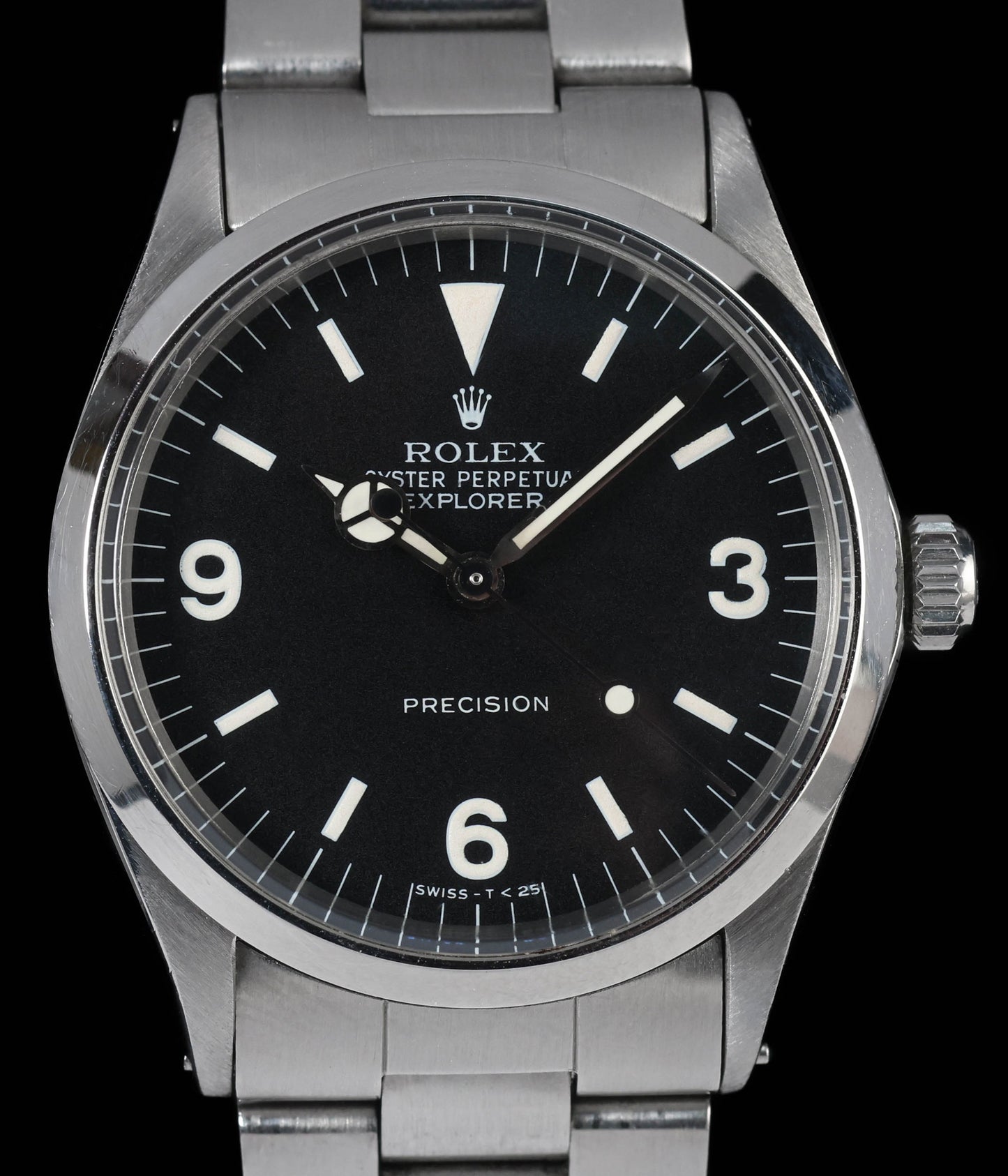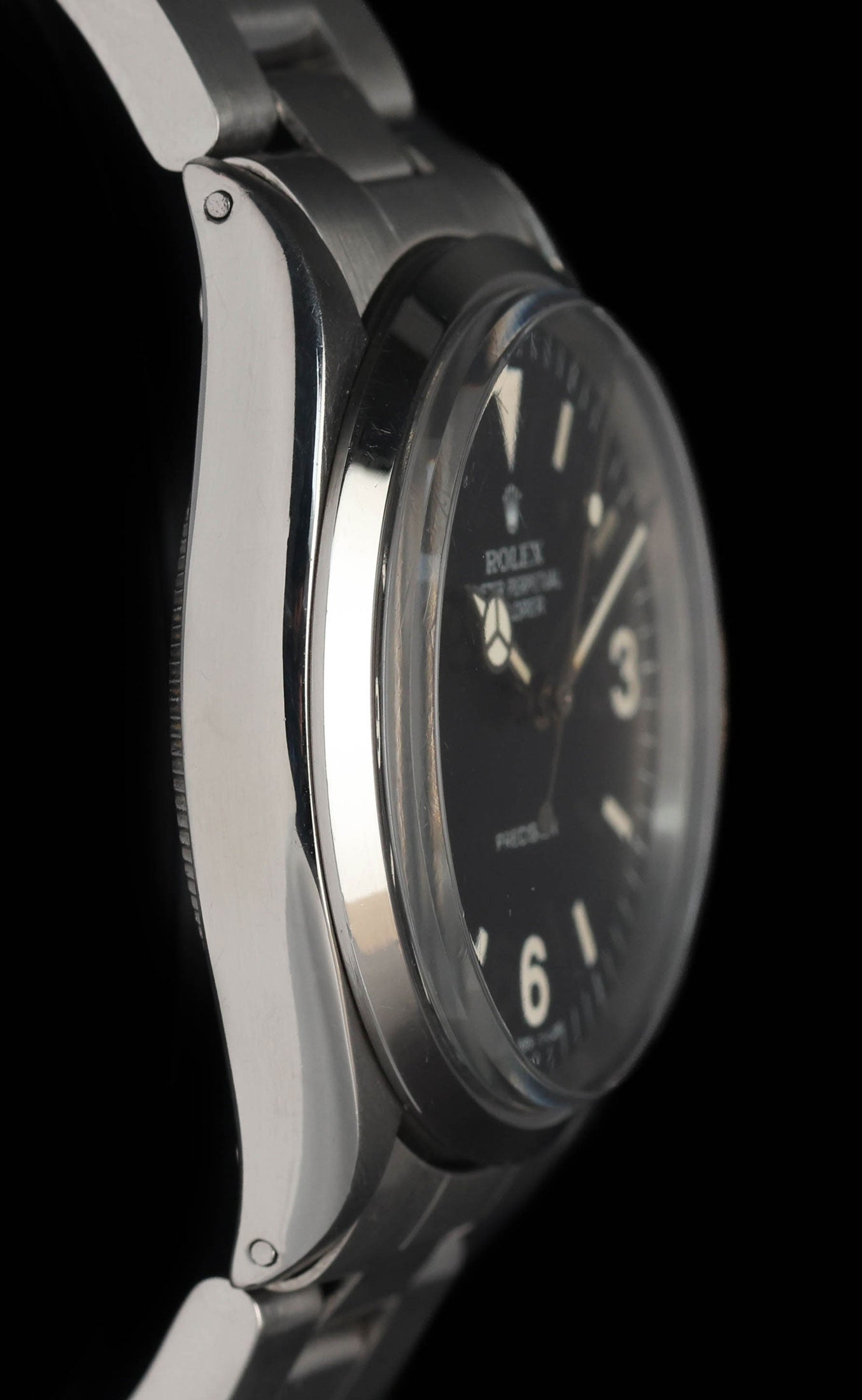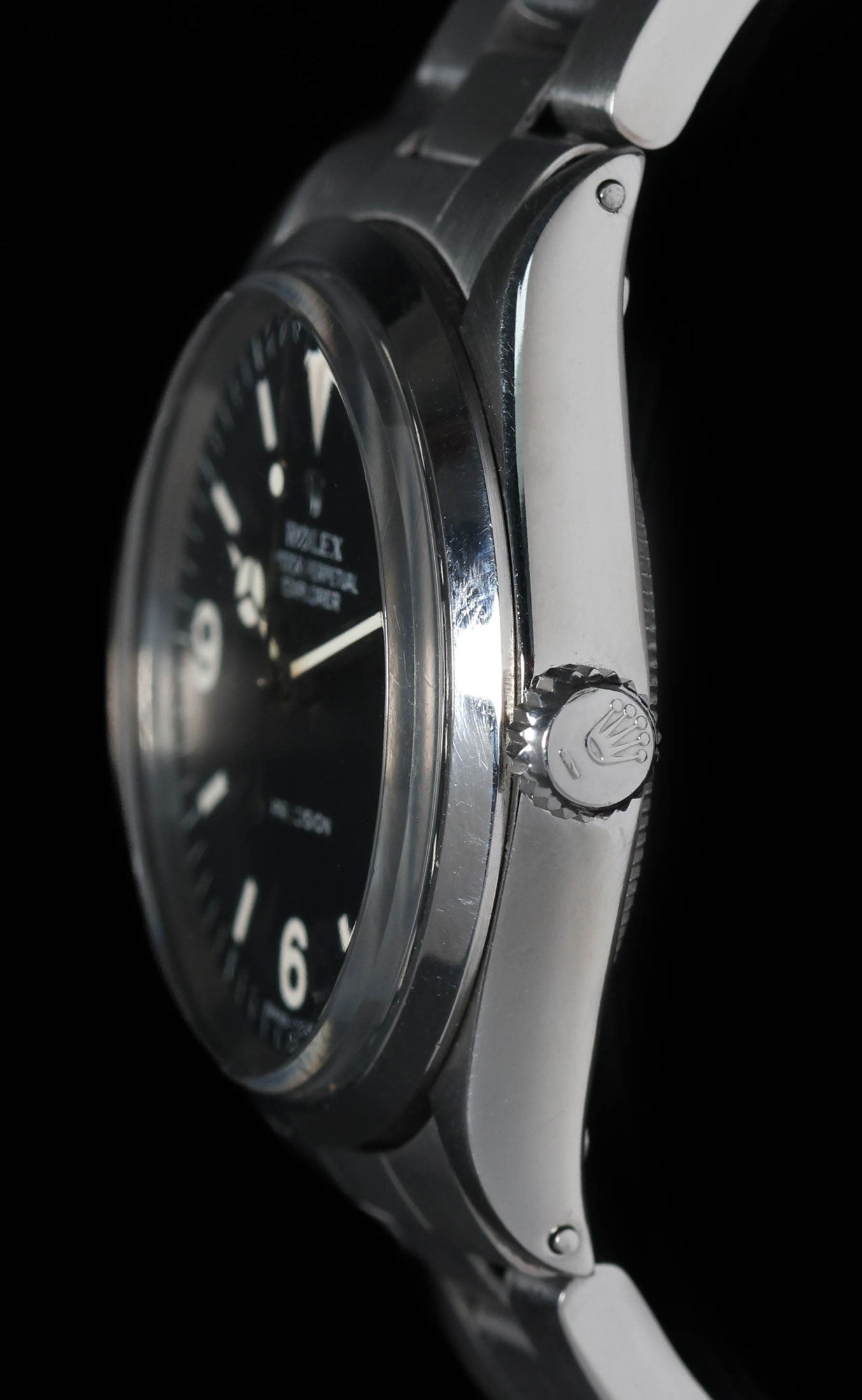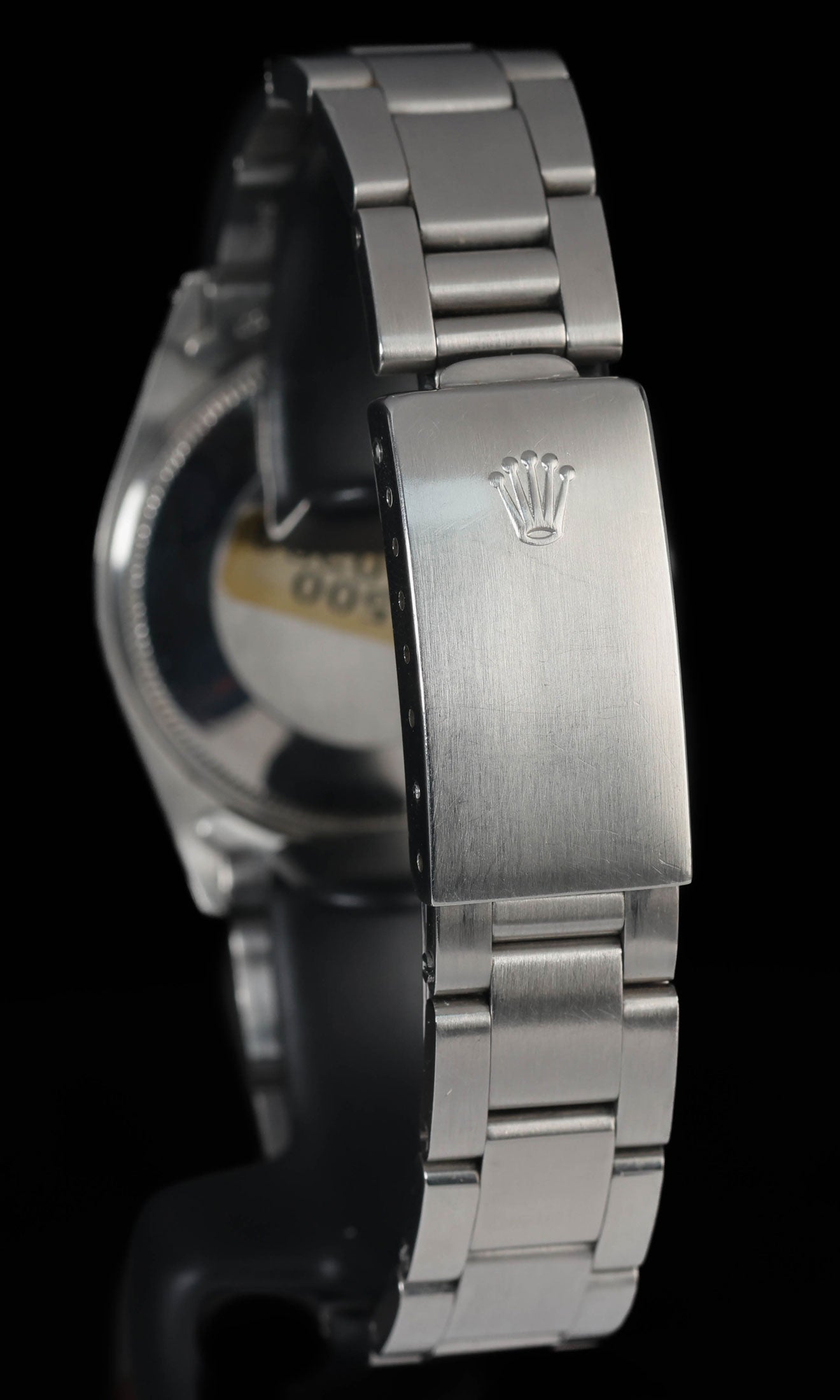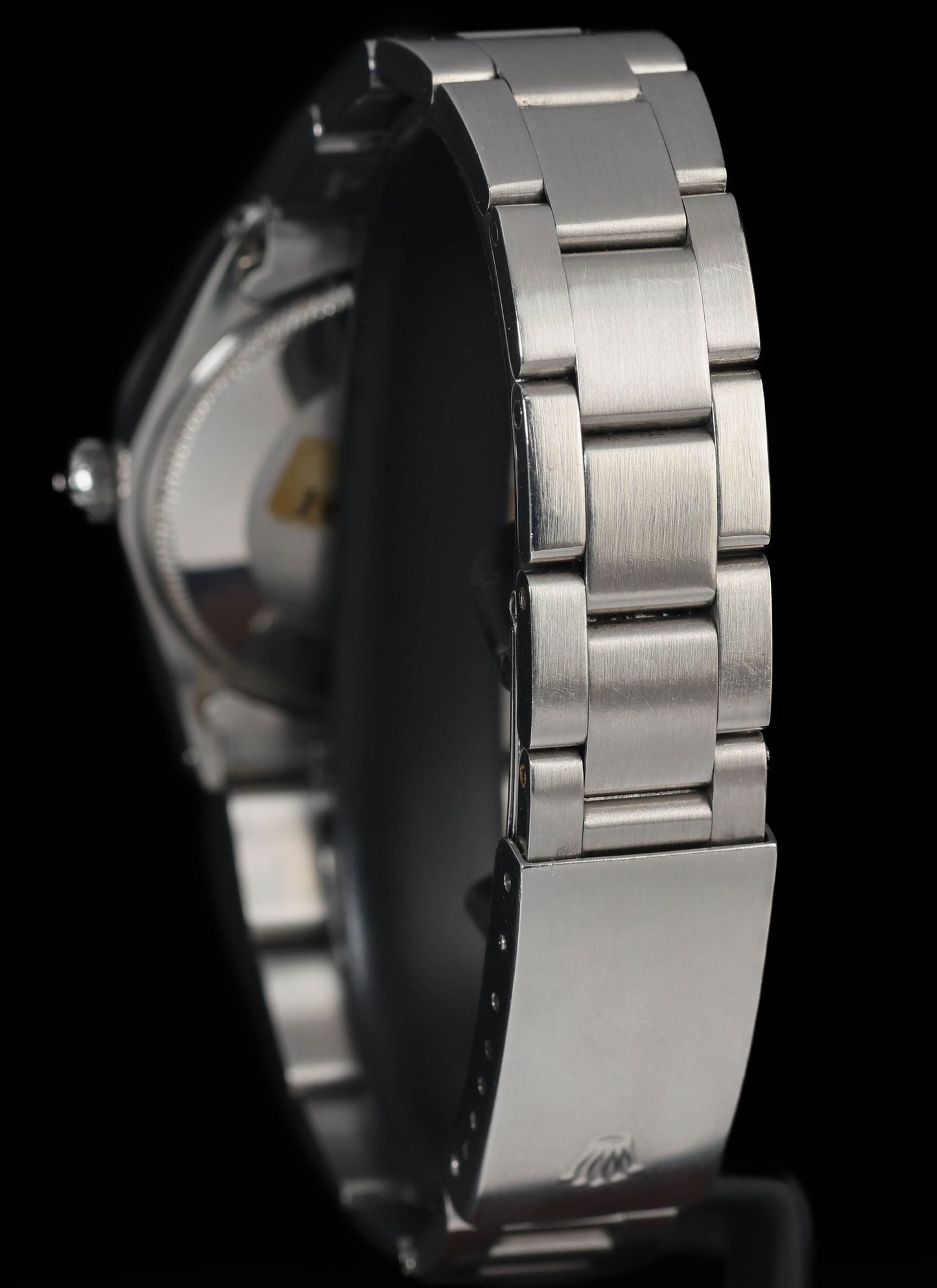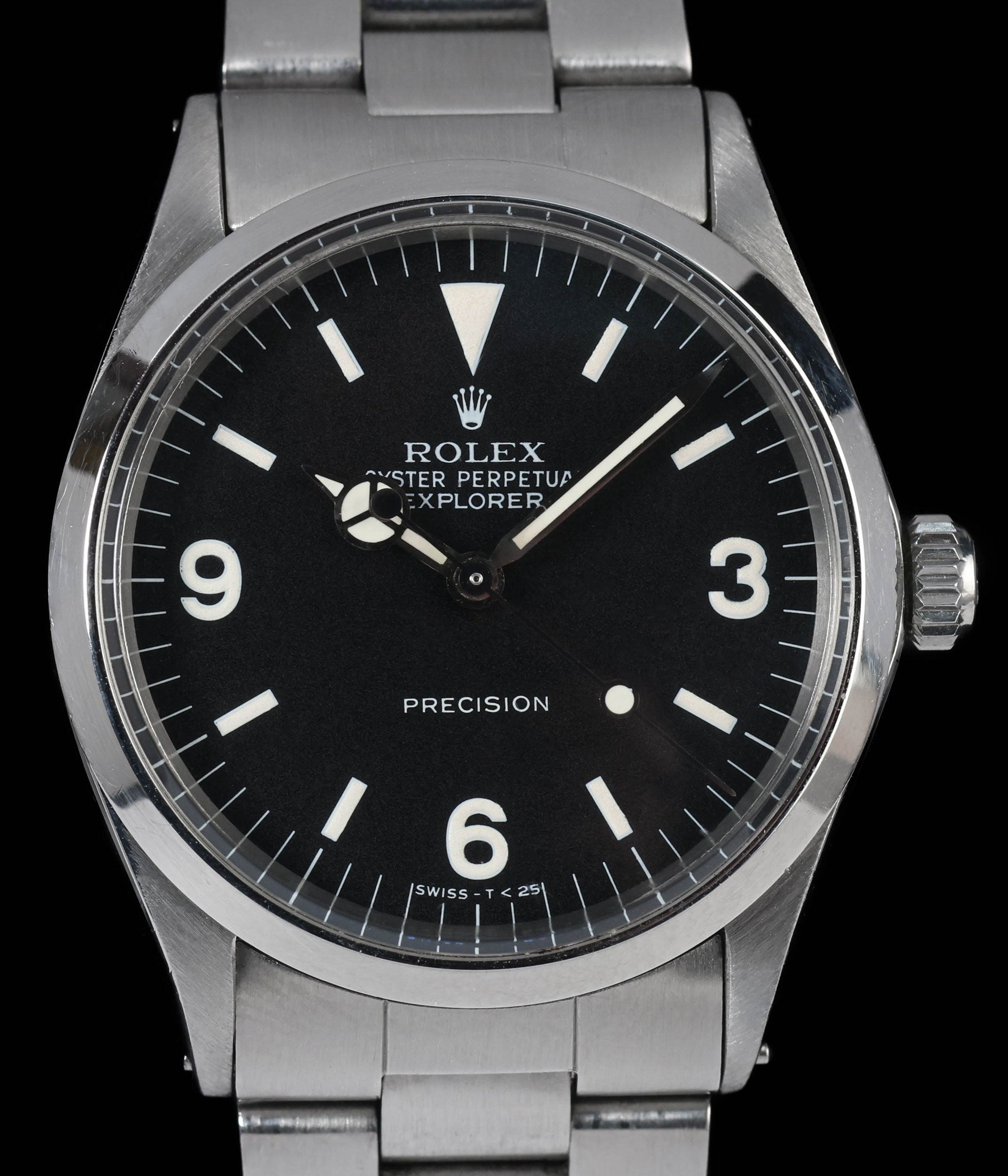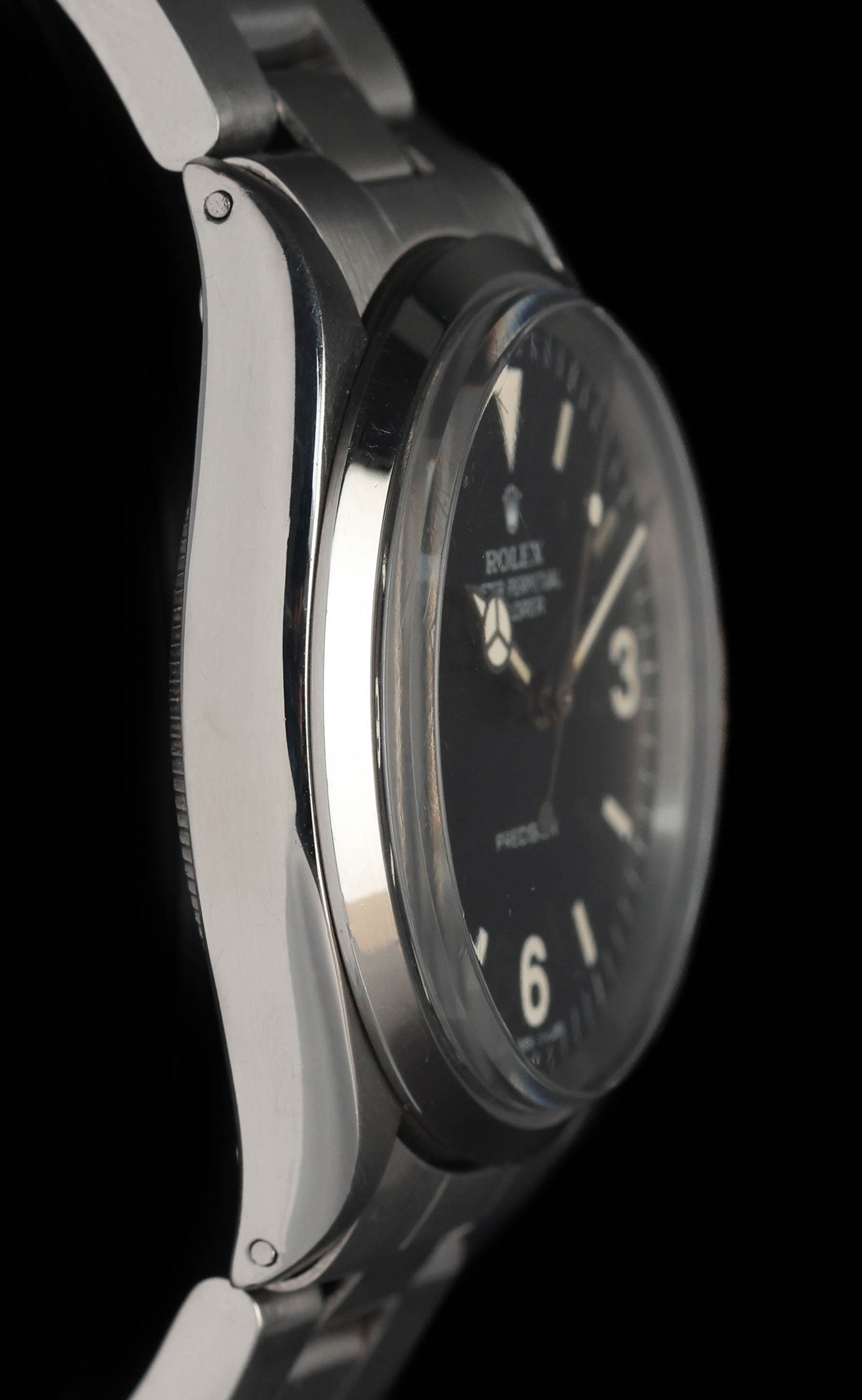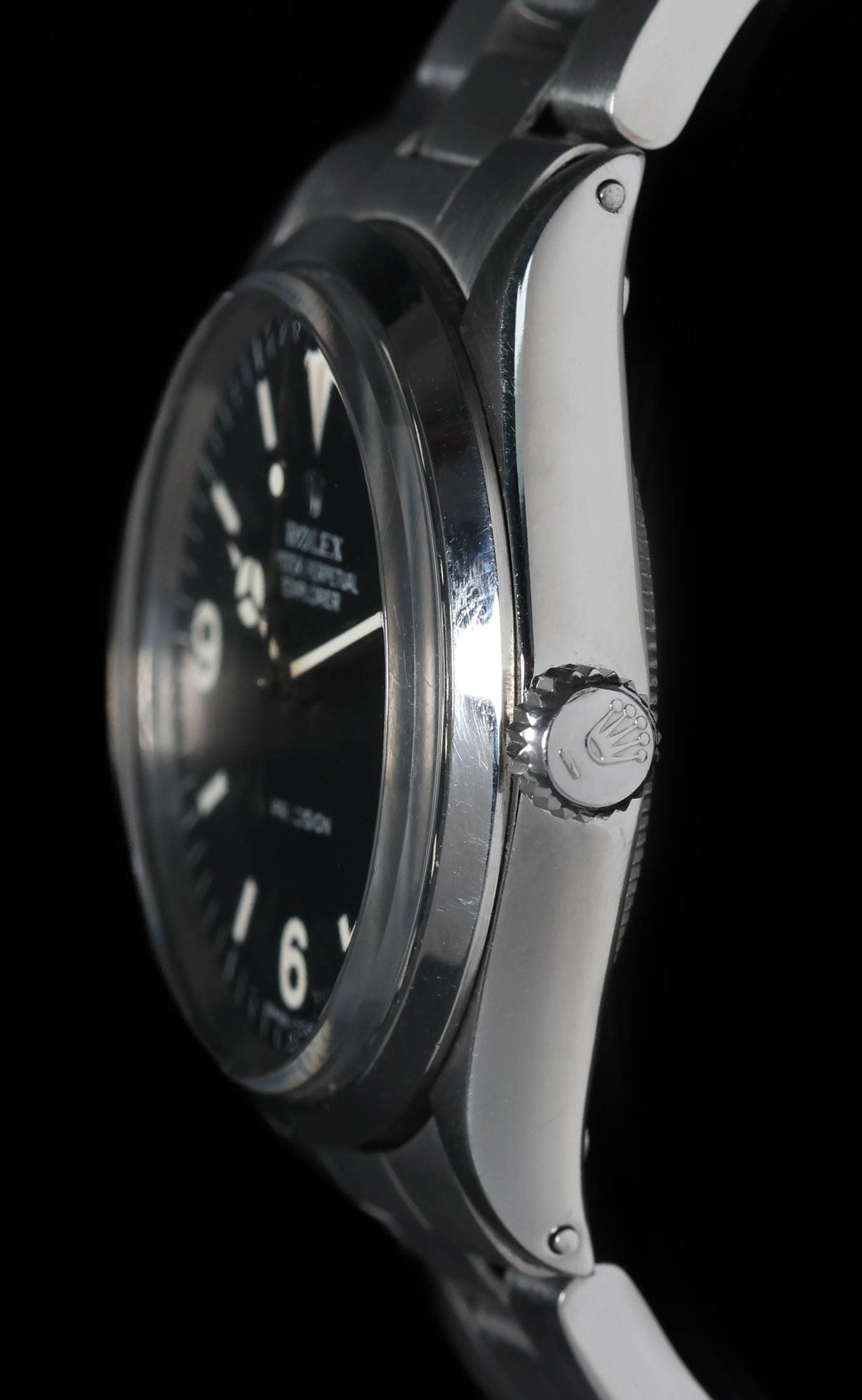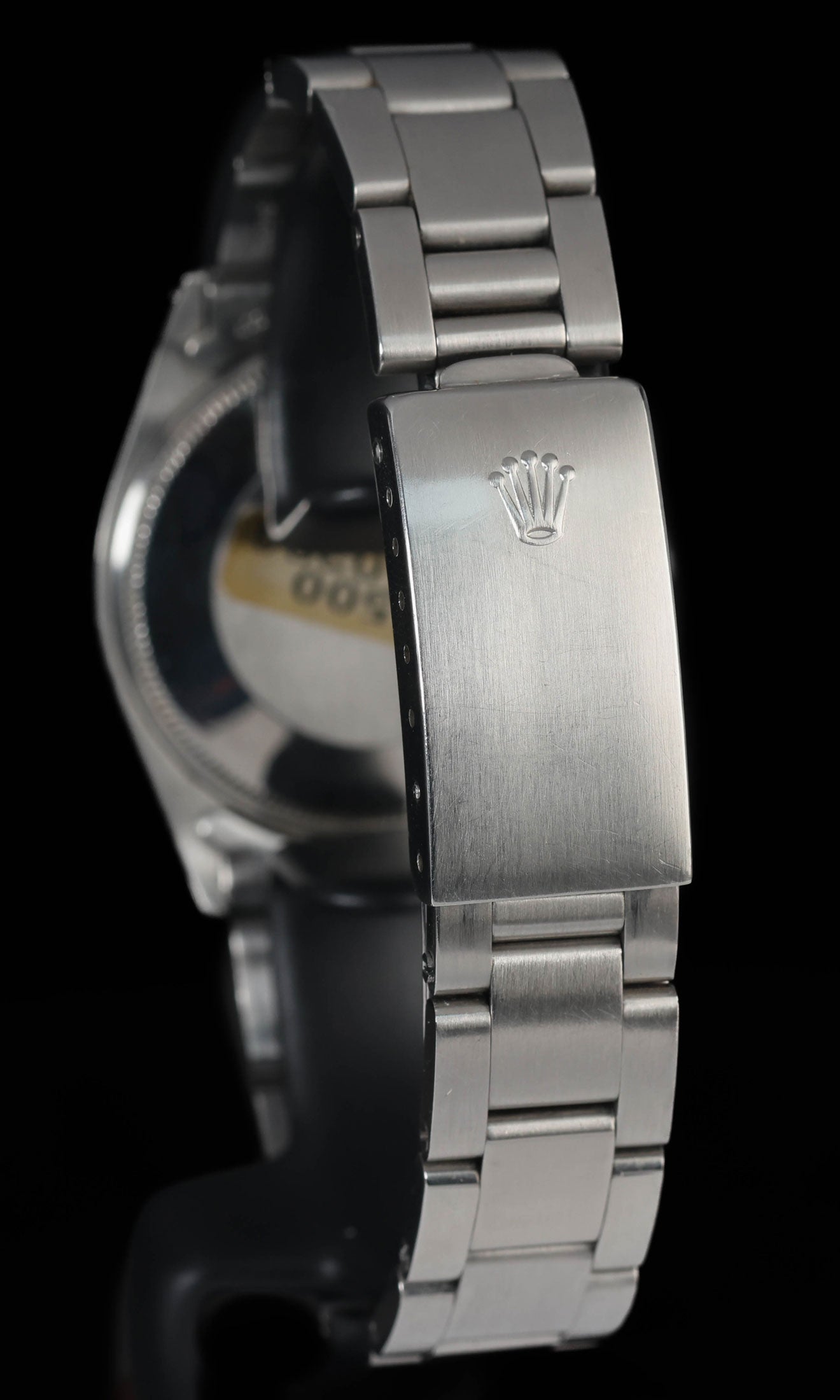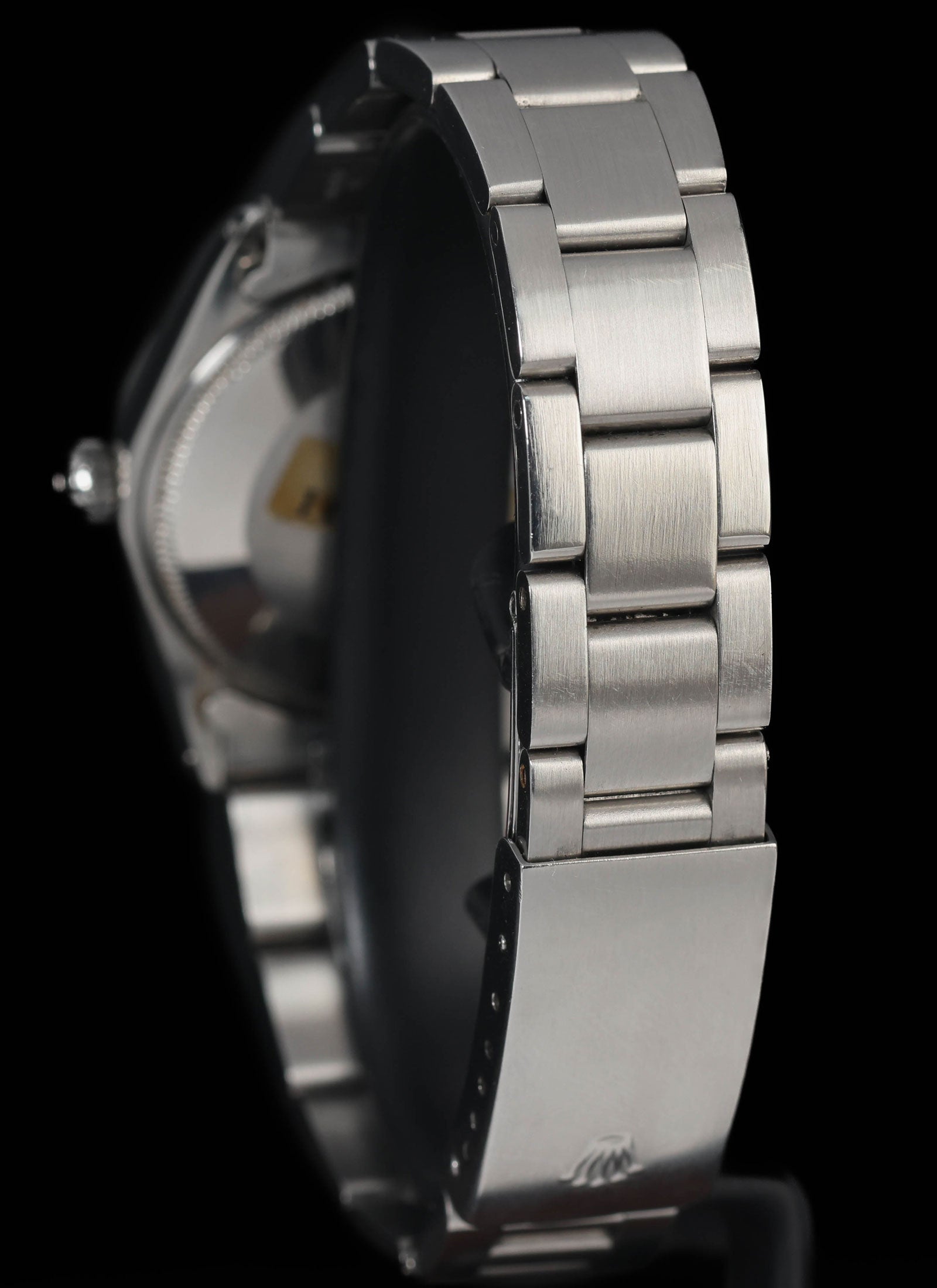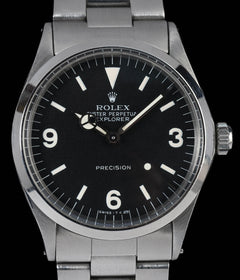Crown Vintage
Rolex Explorer 5500 34mm Circa 1968
Rolex Explorer 5500 34mm Circa 1968
Couldn't load pickup availability
Overall in very good vintage condition. The stainless-steel case shows only light hairlines from careful wear, with sharp lugs and intact factory chamfers. Smooth bezel has faint superficial scratches that sit wholly in the surface finish. Original matte black 3-6-9 dial is excellent, with clean tritium plots ageing to a warm parchment hue; matching Mercedes hands are likewise flawless, free of corrosion or flaking. Acrylic crystal is clear with no notable marks. Crown screws down securely, and the automatic calibre winds, sets and runs within expected tolerances. Oyster rivet bracelet displays minimal stretch and minor desk scuffs, completing a well-preserved 1968 Explorer 5500 that has never seen heavy use or inappropriate polishing.
Share
Why we love this watch
Why we love this watch
Rolex Explorer 5500: Compact Adventurer with Air-King Roots
Origins of the Explorer Line
The Rolex Explorer story begins in the early 1950s, when the company’s Oyster Perpetual models accompanied successive Himalayan expeditions. After Sir Edmund Hillary and Tenzing Norgay summited Everest in 1953 with Oyster watches strapped over their sleeves, Rolex formalised the “Explorer” name, launching references 6350 and 6150 the same year. These 36 mm pieces featured the now-familiar 3-6-9 Arabic dial, generous luminous paint and a calibre A296 automatic movement. Over the next decade the Explorer would evolve into the reference 1016, introduced in 1960 and produced until 1989, cementing the model’s reputation as a reliable, time-only tool watch built for extremes.
Yet alongside the headline-grabbing 36 mm Explorer sat a quieter sibling: the reference 5500. Produced between the late 1950s and early 1970s, it offered the same rugged ethos in a smaller 34 mm case borrowed from the Air-King. By 1968 the 5500 occupied a curious niche—technically an Explorer, mechanically an Air-King, and marketed almost exclusively in Commonwealth countries such as Canada and the United Kingdom.
The Reference 5500: An Explorer in Disguise
Rolex assigned the 5500 stock number to the Air-King in 1957, pairing the new case with the calibres 1530 and 1520. For retailers requesting an Explorer variant, Rolex simply fitted an Explorer dial and hands to the same hardware. No separate reference number was issued, so period catalogues list both Air-King and Explorer 5500 under the single 5500 umbrella. This parts-bin approach kept production costs low and allowed dealers in smaller markets to satisfy customers who wanted the glacier-tested Explorer look but preferred (or could only obtain) a 34 mm size.
While the standard 36 mm Explorer 1016 used a chronometer-rated calibre 1570, the 5500 was almost always powered by the non-chronometer calibres 1520 (17 jewels) or 1530 (26 jewels), both automatic, hacking and beating at 19,800 vph. To avoid any suggestion of chronometer certification the dial text reads simply “Precision” or, on earlier examples, “Super Precision”. Otherwise the gilt or white printing, Mercedes-style hour hand and straight seconds hand mirror its larger cousin.
Case and Proportions
The 34 mm Oyster case of the 5500 measures approximately 11 mm thick with a 19 mm lug width and retains the same screw-down crown and Twinlock tube found on the 1016. On-paper dimensions sound modest today, yet the broad bezel and straight-flank Oyster case give it wrist presence beyond its diameter. The smooth bezel—shared with the Air-King—keeps reflections to a minimum, emphasising the matte dial. Twin-lock crowns are signed with the single underline beneath the coronet, a detail phase-appropriate for 1968.
Movement and Performance
By 1968 most Explorer 5500 watches left Geneva with the calibre 1520. Though not COSC-tested, the movement features a robust free-sprung balance with Microstella screws and KIF shock protection. Service documentation from authorised Rolex workshops routinely demonstrates daily rates within ±5 seconds even after decades of wear, underscoring the practical reliability that defined Rolex tool watches of the era. The rotor is bi-directional, winding in both directions via a 360-degree pivoting weight, and transmits torque through a reduction gear train that is thicker than contemporaneous ETA designs, aiding long-term durability.
Dial Variations and Luminescence
Collectors recognise three broad dial styles for the Explorer 5500.
- Gilt chapter ring (1958–1963): Glossy black with gold print, closed minute track and radium lume on the 3-6-9 Arabic markers and triangle at 12. Most examples feature “Explorer” in gilt below the coronet.
- Early matte (1963–1966): A transitional dial ditching the gilt print but retaining gilt logo and text outlines. Lume switches to tritium, indicated by a small “T SWISS T” at six o’clock.
- Late matte (1966–approximately 1972): Completely white print on a charcoal-grey matte surface, a cleaner aesthetic aligned with the 1016 of the same era. These dials usually carry the “T < 25” tritium marking introduced in 1964 in compliance with new radiation standards.
The year 1968 sits squarely in the late-matte period. Dials from this year often display light grain under magnification, a visual texture created by the phosphate basecoat Rolex adopted to improve tritium adhesion. Hands retain the classic Explorer layout: Mercedes hour hand, simple baton minute hand and lollipop seconds with a pointed tip. Luminous compound on 1968 examples ages to a parchment tint, often matching the plots precisely because Rolex applied dial and hand lume in the same production batch.
1968 Production Context
To appreciate a 1968 Explorer 5500, it helps to view Rolex’s broader catalogue that year. The company had just unveiled the reference 1680 Submariner with date, the Cosmograph 6263, and the earliest Red Sub dials were arriving at retailers. Against such bold tool watches the 5500 looked almost conservative, yet its smaller diameter appealed to buyers who worked in offices Monday to Friday but still wanted a watch capable of copping a rainy weekend hike.
Rolex shipped relatively few 5500 Explorers compared with the Air-King; internal sales ledgers suggest fewer than one Explorer left the factory for every fifty Air-Kings of the same reference. Most orders were filled through Canadian distributors such as R.C. Nichols, which explains why many surviving examples today surface in Toronto and Vancouver with original punched guarantee papers from Canadian jewellers.
Australian jewellers rarely listed the 5500 Explorer, given that the larger 1016 was already popular with mining workers in Western Australia and climbers tackling New Zealand’s Southern Alps. However, secondary importers occasionally secured small batches, and period adverts in the Sydney Morning Herald show Explorer dials on 34 mm Oyster cases priced at roughly A$155—about ten percent cheaper than the 1016 at the time.
Wearing Experience and Cultural Footprint
The defining characteristic of the 5500 is its balance between discretion and purpose. At 34 mm it slips easily under a shirt cuff, yet the bold 3-6-9 numerals broadcast its Explorer heritage. Unlike the 1016’s 36 mm case, the smaller bezel leaves a proportionally larger dial aperture, so legibility remains excellent. The rivet-link Oyster bracelet (reference 7205) supplied in 1968 tapers from 19 mm to 14 mm at the clasp, exaggerating the watch’s slim profile.
While the 1016 appeared on the wrists of notable mountaineers and even NASA technicians, documentation of high-profile figures wearing the 5500 is scarce. Its audience was ordinary people who prized reliability over prestige: mining geologists, surveyors, forestry managers—professions that demanded a watch impervious to dust, water and temperature swings. Company records from British Columbia’s ministry of forests list “Rolex Explorer 5500” under approved equipment for field engineers in 1969, alongside Silva compasses and Zeiss rangefinders.
Market Reception and Legacy
Sales figures for the Explorer 5500 never approached those of its 36 mm sibling, and Rolex discontinued the variant around 1972. Its modest commercial performance stemmed partly from internal competition—customers willing to spend Explorer money often chose the larger 1016—and partly from shifting fashion towards bigger cases. Still, the 5500 carved out a legacy as the Explorer for those who valued understatement and comfort.
Unlike many Rolex sports references, the 5500 remained virtually unchanged throughout its run: no crown guards, no chronometer text, no exotic dial colours. This consistency means a 1968 example looks almost identical to one from 1962 or 1970, save for lume type and minor typography shifts. Such continuity underscores Rolex’s incremental approach to improvement—small tweaks rather than annual overhauls.
The watch also reminds us that reference numbers in the Rolex lexicon are not siloed. By transplanting an Explorer dial into an Air-King case, Rolex blurred the boundaries between model families years before the term “frankenwatch” entered collector vocabulary. Yet unlike modern hybrids assembled by hobbyists, the 5500 Explorer was entirely factory-authorised, highlighting Rolex’s pragmatic view of meeting regional demand.
Final thoughts
The 1968 Rolex Explorer 5500 distils the ethos of the Explorer line—legible, reliable, no-nonsense timekeeping—into a more compact, understated package. Its Air-King ancestry, non-chronometer movement and restrained 34 mm case make it an outlier in the canon of Rolex sports models, yet these very traits grant it unique charm. Viewed through today’s lens, the 5500 is a reminder that adventure comes in many sizes and that Rolex’s history is richer than headline references alone. Given its limited production and unpretentious design, the 1968 Explorer 5500 stands as a quietly significant waypoint in the brand’s continuous pursuit of functional excellence.
Case & Bracelet
Case & Bracelet
Very good condition with minimal signs of wear. Bezel has light hairline scratches.
Dial & Hands
Dial & Hands
Excellent condition
Warranty & Condition
Warranty & Condition
Crown Vintage Watches provides a minimum 3-month mechanical warranty on pre-owned watches, from the date of purchase.
The warranty covers mechanical defects only.
The warranty does not cover damages such as scratches, finish, crystals, glass, straps (leather, fabric or rubber damage due to wear and tear), damage resulting from wear under conditions exceeding the watch manufacturer’s water resistance limitations, and damage due to physical and or accidental abuse.
Please note, water resistance is neither tested nor guaranteed.
Shipping and insurance costs for warranty returns to us must be covered by the customer. Returns must be shipped via traceable courier. Return shipment must be pre-paid and fully insured. Collect shipping will be refused. In case of loss or damages, the customer is liable.
Our Pledge
At Crown Vintage Watches, we stand by the authenticity of every product we sell. For added peace of mind, customers are welcome to have items independently authenticated at their own expense.
Condition
Due to the nature of vintage timepieces, all watches are sold as is. We will accurately describe the current condition and working order of all watches we sell to the best of our ability.
Shipping & Refund
Shipping & Refund
